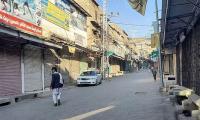As a police chief, it was so painful to read the ‘morning crime diary’, summarizing how violent we have become. It is unfortunate that cases of violence against women (VAW) are rarely reported for fear of stigma. A sobbing father once asked me: “who will marry her, once she grows, knowing what had happened to her in the formative years?”
Statistics show that 66,000 women are killed violently every year and account for 17 percent of global homicides. And, while no country in the world is 100 percent safe for women, this does not absolve us from our obligation to eradicate VAW from our country and society.
It is a fact that VAW is mainly due to attitude and rearing, patriarchs living with a perception of superiority, complexes, inhibitions, entitlements, misogyny, and misinterpreted ideologies. In our society, it is prevalent because of historically unfair power relations between men and women, which force the latter into a subordinate position.
The truth is that violence against women has been accepted and even condoned because many in our society reduce it to a ‘domestic’ or ‘private’ matter. We are a predominantly Muslim society and our religion emphasizes due respect to women, but sadly we are currently ranked 67 in the Safety and Crime Index list amid the Southern Asia Safety Index of surveyed 133 countries. And, as per the World Economic Forum’s global gender index of 2020, we were ranked 153 out of the assessed 156 countries.
Paradoxically, though the police are inefficient and corrupt, they are there to prevent and detect all crime, irrespective of the root causes. Nevertheless, blaming the victim, being fearful of acting against the powerful or of being held accountable, adds to victims’ miseries and in turn emboldens criminals into repeating their crimes.
Police overreaction, especially in high-profile cases, may also wear down due process due to the pressure and the hype. Pushing the investigating officer to quickly finalize the investigations, holding press talks etc, instead of concentrating on the investigation stages is likely to end up in the police overlooking substantial incriminating evidence resulting in exoneration of the accused.
We have seen in cases of VAW, legal procedural delays on one pretext or another, and reducing even the bravest of victims into fear through nasty questions during investigation and court proceedings. There is no doubt that the criminal justice system's inadequacy does catalyze all such unfortunate incidents, particularly,when it doesn’t swiftly dispose of cases. At the societal level, a culture of involving the entire clan of a perpetrator in the offence is unfair as is the alleged culprit and his coterie using all tactics to get the charges dropped.
The record reveals that in 2020, around 0.87 million criminal cases were registered all over Pakistan, though the number could swell to two million if every crime were reported or recorded. Sadly 4888 cases (0.557 percent) were of VAW recounted during the Covid-19 pandemic in 2020. These included murder, honor killings, rape, suicide, acid burning, kidnapping, domestic violence, forced marriage, etc. Analysis reveals that 57 percent of these offences occurred in Punjab, 27 percent in Sindh, 8 percent in Khyber Pakhtunkhwa, 6 percent in Gilgit-Baltistan and 2 percent in Balochistan.
The prevalent system, at times, can be quite merciless when it comes to justice. In the Mukhtar Mai rape case (2002) the accused was acquitted for "insufficient evidence". In Ghazala Javed, the playback singer murder (2012), the sentence was set aside based on compromise between the heirs of the victims. In the Qandeel Baloch murder (2016) her brother confessed to the murder saying she was "bringing disrepute" to the "family's honour" while in the Khadija Siddiqui stabbing case (2016) the accused after serving 3.5 years against his five years, was released on "technical remissions" (July 2021).
The constitution of Pakistan safeguards women’s fundamental rights. However more recognition at the national level with consistent follow-up is required. It is time for proper classifications of women's basic rights like autonomy, representation, and freedom. Reforms are required in the police departments and judicial processes to remove hurdles in the way of women accessing justice.
At the same time, we can create and discover counter-VAW programmes that have yielded tangible results. It’s time to work out and overcome the root causes of VAW and develop a pragmatic response. The best way forward is to imitate effective models in vogue worldwide to contain its triggers.
One such, ‘The Social-Ecological Model,’ a Framework for Prevention of VAW suggests analyzing factors, shaping people's behaviour towards this violence to help establish programmes and prevention strategies. It uses a four-level social-ecological paradigm on the complex interplay and influencing factors between individuals, relationships, communities, and societal factors besides suggesting to act across multiple levels of the model at the same time to achieve population-level impact (Dahlberg LL, Krug EG, WHO).
But it is also time that we all see gender as a continuum instead of a two-stage set of hostile values. It is so strange that we love women as daughters, sisters, wives, mothers and yet are not ready for their social inclusion. Women will stop being suppressed only when we change society’s chauvinistic mentality and insist on equal opportunity for all.
The perpetrators of shameful and horrific crimes, such as the one committed on the Lahore–Sialkot link road against a woman in front of her children, should be given swift and exemplary punishment so that no one can dare think of committing such a horrendous crime. Let’s be clear that any violence perpetrated or condoned by the state or its officials or the community only ends up ensuring recurrence.
Such crimes are not far away anymore; they are just around the corner. Are we doing anything to address the root causes, to overcome this pathological problem and improve our response mechanism? A collective response is the need of the hour – or maybe an implementable national action plan. Mere lip service hasn’t and won’t serve any purpose. Our’s should not be a dark and gloomy ‘wasteland’.
The writer, a security expert, holds a PhD in Politics & International Relations, and is presently serving as IGP NHMP.
Email: skimam98@hotmail.com
Most recently, US presidential elections demonstrated how AI has amplified partisan split
Few years ago, Pakistan ranked as fourth-largest freelancer market globally, with potential to become number one
Arts Council Karachi celebrated its 70th birth anniversary at inaugural session with big cake
There are over 11 million Pakistanis settled abroad, out of which around six million work in Gulf and Middle East
This year alone, US Treasury would have to roll-over $10 to $14 trillion in maturing short-term debt
Tear gas no longer marks just protest sites; it paints entire cities as battlegrounds but then again, PTI did it first







